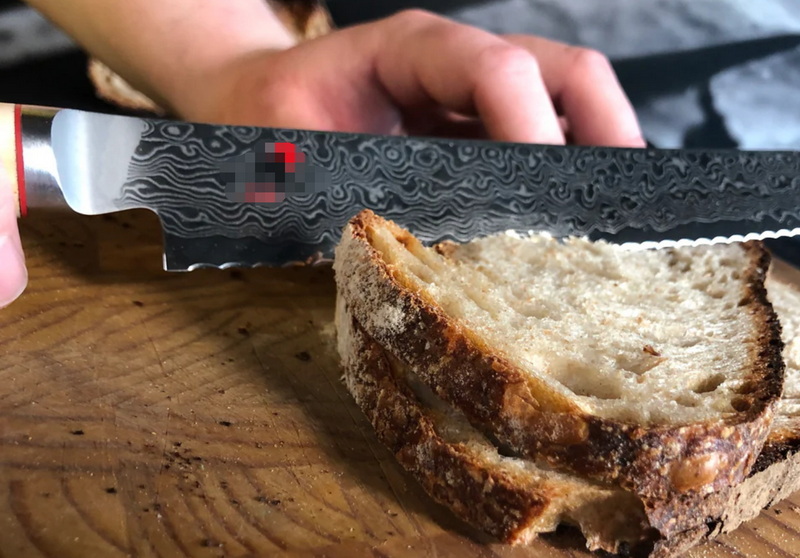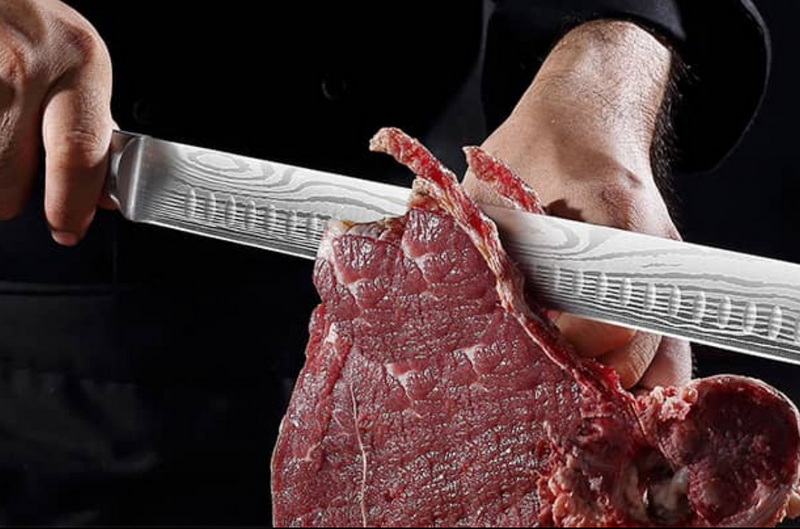- All
- Product Name
- Product Keyword
- Product Model
- Product Summary
- Product Description
- Multi Field Search
Views: 222 Author: Ann Publish Time: 2025-11-06 Origin: Site











Content Menu
● Applications and Performance
● Ergonomics and User Experience
● Applications and Performance
● Ergonomics and User Experience
● Performance Comparison: Bread Knife vs Slicing Knife
● Considerations for OEM and Marketing
● Case Studies: Market Scenarios for OEM Partners
● Interchangeable Design Features
● Quality Assurance and Standards
● FAQ
>> Can a Bread Knife be used for dry meats or fish?
>> What is the best way to sharpen a Bread Knife?
>> Are Bread Knife and Slicing Knife interchangeable in professional kitchens?
>> How does blade length affect performance?
>> Which knife is better for everyday home use?
In professional OEM kitchen knife projects, selecting the right blade type is pivotal for product performance, user satisfaction, and brand credibility. Bread Knife and Slicing Knife are two fundamental tools that often shape the perception of quality in consumer kitchens. This comprehensive article delves into the design philosophies, performance characteristics, material considerations, ergonomics, and practical applications of both Bread Knife and Slicing Knife. It highlights how nuanced differences—such as edge geometry, blade thickness, and handle design—translate into tangible outcomes in real-world cooking scenarios. The aim is to provide foreign brands, wholesalers, and manufacturers with a thorough, practically implementable understanding that supports intelligent product development, clear marketing positioning, and confident OEM decision-making.

A Bread Knife is a long-bladed utensil featuring a serrated edge designed to cut through crusty exterior surfaces without crushing the delicate interior crumb. The toothed edge grips the crust, enabling a sawing motion that creates clean, even slices with minimal crumb damage. Bread Knife designs vary, but the serration pattern remains the defining element that differentiates it from straight-edged blades. In many markets, bread knives span approximately 7 to 10 inches, offering versatility for various loaf sizes while maintaining ergonomic balance for repetitive slicing tasks. For OEM programs, bread knife variants often emphasize serration type (coarse vs fine), tooth geometry, and edge retention strategies to meet consumer expectations for crust-breaking performance and crumb preservation. The Bread Knife's role extends beyond bread, proving useful for certain fruits with tough skins and soft interiors when used with care. This practical versatility makes Bread Knife an essential component of a well-rounded knife lineup and a strong candidate for marketing narratives focused on everyday reliability and baking culture.
- Serrated Edge: The hallmark of the Bread Knife, designed to saw through crusts with minimal downward pressure, preserving crumb integrity.
- Tooth Pattern: Coarser teeth excel at heavy crusts, while finer teeth offer smoother slices on lighter loaves. Edge geometry can influence cutting speed and crumb retention.
- Blade Thickness: Typically thicker than many straight-edged knives to sustain stability during sawing, while avoiding excessive weight that could fatigue users over long sessions.
- Blade Length: Commonly 7–10 inches, balancing reach with control for typical bakery and home bread portions.
- Gut-Check for OEM: When crafting Bread Knife variants for international markets, consider the target bread styles (artisan sourdough, baguettes, sandwich loaves) to tailor tooth density, spacing, and overall blade rigidity.
Bread Knife excels at crusty, dense, or chewy crusts. The serrated teeth initiate contact with hard crusts, while the gaps between teeth reduce suction and drag, allowing smoother traversal through the crust without tearing the crumb. This behavior benefits bakery tasks, daily home bread slicing, and even delicate pastry portions that require controlled portioning without crushing. Although Bread Knife's primary function is bread-related, its utility extends to slicing tomatoes or soft-skinned fruits where a careful sawing action minimizes damage to soft interiors.
A well-designed Bread Knife balances blade mass, handle grip, and weight distribution to enable confident, repetitive sawing. Ergonomic considerations include:
- Handle Material and Contour: For extended use, a comfortable, non-slip handle reduces hand fatigue and enhances precision.
- Balance Point: A well-balanced knife reduces wrist strain during long slicing sessions.
- Maintenance Familiarity: Serrated edges maintain cutting performance longer between sharpenings, but when sharpening is necessary, specialized tools or professional services are often recommended.
A Slicing Knife is engineered for precision, long, clean cuts of meats, roasts, fish, and large fruits. The blade is typically straight or mildly curved and may be straight-edged or hollow-ground (Granton) to reduce sticking. The Slicing Knife prioritizes a smooth cutting action with minimal resistance, enabling even, uniform slices that preserve texture and moisture. In many professional kitchens, Slicing Knife lengths range from 8 to 14 inches, chosen to match the size of the target protein or fruit. For OEM bundles, Slicing Knife variants are commonly tracked by blade geometry (straight vs Granton), grind type, and edge retention properties, enabling brands to position products toward culinary professionals who value precision and presentation.
- Straight Edge: Traditional choice for clean, uninterrupted slices on meats and fish.
- Hollow-Ground Edge (Granton): Tiny cavities along the blade reduce surface contact, enabling smoother gliding and reduced sticking with moist foods.
- Flexibility: Slicing Knife blades may exhibit slight flexibility to facilitate cutting around bones and joints without tearing the flesh.
- Blade Material: High-carbon stainless steels or premium alloys provide a balance of edge retention, corrosion resistance, and ease of maintenance.
- Handle Design: Ergonomics emphasize control and finesse, with attention to grip texture, shape, and balancing to support long preparation sessions.
- Primary Uses: Thin, uniform slices of roasts, hams, smoked fish, and large fruits; diurnal precision is essential for presentation in fine dining or catering settings.
- Edge Maintenance: Regular honing and sharpening are necessary to preserve the smooth-edged performance. Honing aligns the blade edge between professional sharpenings.
- Multi-Role Utility: Slicing Knife can handle delicate vegetable slicing (like cucumbers or potatoes) when a trained hand applies a steady pull/push motion with minimal pressure.

A top-tier Slicing Knife design emphasizes seamless control, fatigue resistance, and tactile feedback. Key ergonomic considerations include:
- Handle Alignment: A slightly forward-leaning handle reduces wrist torque during extended cutting sessions.
- Finger Guard: Provides safe finger positioning and prevents slippage during long tasks.
- Weight Distribution: A well-balanced blade improves stability and allows precise control when adjusting slice thickness.
- Edge Type: Bread Knife uses serrated edges to handle crusts; Slicing Knife uses straight or hollow-ground edges for smooth, even cuts.
- Cutting Motion: Bread Knife employs a sawing motion; Slicing Knife relies on a controlled pulling/pushing action.
- Primary Use: Bread Knife for crusty bread and crumb preservation; Slicing Knife for meats, fish, and large fruits with uniform thickness.
- Maintenance: Bread Knife serrations resist dulling but require specialized sharpening; Slicing Knife edge maintenance is more straightforward with standard sharpening tools.
- Market Position: Bread Knife often marketed toward home bakers and casual cooks; Slicing Knife targets professional kitchens and serious home cooks demanding precise portioning.
- Brand Positioning: If the brand strategy emphasizes bakery culture, emphasize Bread Knife's crust-cutting prowess and crumb-sparing design. For culinary professionals, position Slicing Knife as the precision instrument for meat and fish.
- Material Selection: Choose steel grades that balance hardness, corrosion resistance, and ease of sharpening, matching regional market expectations and maintenance practices.
- Packaging and Education: Provide clear usage guides and care instructions highlighting Bread Knife's serration advantages for bread, and Slicing Knife's performance for proteins. Use imagery and videos that show crust-slicing vs. precise meat slicing to reinforce differentiation.
- After-Sales Support: Offer maintenance kits or sharpening services tailored to serrated vs straight-edged blade care, reinforcing value in international markets where service infrastructure varies.
- Bread Knife Slicing Technique: Position the loaf on a stable surface, hold the knife with a relaxed grip, and apply a gentle sawing motion; avoid excessive downward pressure to minimize crumb damage.
- Slicing Knife Technique: Use a steady pull/push motion with light pressure, maintaining uniform thickness; align the blade edge with the center of the protein for even slices.
- Maintenance Practices: Regular inspection of serrations on Bread Knife ensures consistent performance; for Slicing Knife, routine honing and periodic sharpening keep the edge crisp.
- Bakery Chain Equipment Package: A Bread Knife-focused lineup with durable serrated edges, ergonomic grips, and branding aligned with artisan bread culture can be marketed to bakery chains seeking reliable, long-lasting performance.
- Catering and Culinary Schools: A Slicing Knife-centric range emphasizing precision cutting, granton edges, and balanced handles can appeal to professional chefs and students for menu execution and plating consistency.
- Multi-Region Branding: For international markets with diverse bread varieties, offering both Bread Knife and Slicing Knife within a coordinated set enables retailers to meet varied customer needs while providing cross-promotional opportunities.
- Edge Options: Provide serrated, straight, and hollow-ground options within the Bread Knife and Slicing Knife families to allow retailers to tailor assortments by region and bread or meat preferences.
- Handle Variants: Supply a choice of ergonomic handles (e.g., pakkawood, reinforced polymer, stainless steel) to suit different climates, cuisines, and maintenance habits.
- Packaging Variants: Include bilingual labeling and QR codes linking to care guides and demonstration videos to support experimental marketing and product education for international brand partners.
- Corrosion Resistance: Stainless steel selection should consider salt exposure in marine or coastal markets; ensure coatings and passivation procedures meet industry expectations.
- Impact Resistance: Verify that serrated Bread Knife joints maintain rigidity under daily use, while Slicing Knife joints tolerate controlled flex without compromising edge integrity.
- Edge Retention: Assess the long-term performance of different steel grades under practical kitchen tasks, including bread crust sawing and meat portioning.
Bread Knife and Slicing Knife occupy distinct but complementary roles in any well-curated knife family. The Bread Knife excels at crust-heavy bread products, delivering clean cuts through serrated action while preserving crumb structure. The Slicing Knife delivers precision, uniformity, and control for meats, fish, and large fruits, emphasizing smooth edges and consistent thickness. For OEM programs, aligning product development with target markets, bread cultures, and professional kitchen practices ensures brands can deliver credible, high-performing tools that meet diverse consumer needs. By integrating thoughtful edge geometry, ergonomic designs, and robust maintenance guidance, manufacturers can create compelling Bread Knife and Slicing Knife offerings that resonate across international markets and strengthen brand value.

Bread Knife can handle some tasks in meats or fish but may not deliver the uniform slices and moisture control provided by a dedicated Slicing Knife; use with caution for best results.
Serrated Bread Knife sharpening typically requires a guided sharpener or professional service; home whetstones are generally unsuitable for serrated edges.
They are not interchangeable; each knife is optimized for specific tasks, and using them appropriately improves portion control and presentation.
Longer blades enable larger slices and reduced number of passes, while shorter blades offer precision and control in tight spaces.
Bread Knife is excellent for crusty bread and certain fruits, while Slicing Knife is favored for home roasts and larger proteins when precision matters.
The Ultimate Professional Knives for Halal Butchery in Middle Eastern Kitchens
Chef Knife Size Guide: Choosing Between 6″, 8″, 10″, And 12″
Custom Knife Handles: How To Design A Chef Knife That Fits Your Hand Perfectly
Chef Knife Surface Treatments Guide: From Polished Migaki To Damascus Patterns
Inside Our Professional Knife Sample Room: Quality You Can See
Universal Knife Block Buying Guide: Modern Acrylic & ABS Knife Holders for Professional Kitchens
Universal Knife Block: The Complete Guide To Modern, Hygienic Knife Storage
The Complete Guide To Red Handle Knife Sets: Style Meets Functionality in The Kitchen
Professional Knives for Halal Butchery And Middle Eastern Cuisine